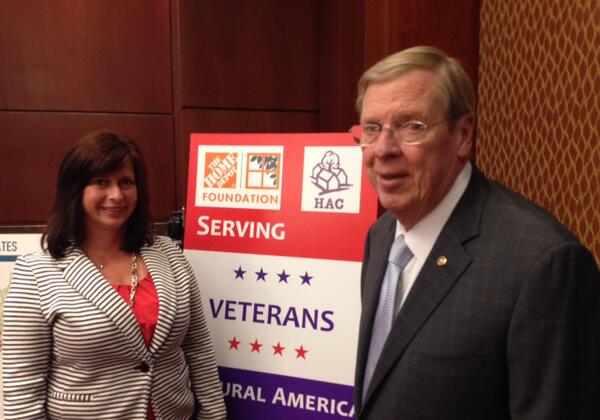 by Eric Oberdorfer
by Eric Oberdorfer
Rural America has a strong history of protecting our country. In fact, veterans are more prevalent in rural America, comprising 11.4 percent of the rural population compared to 9.6 percent of the nation overall. However, providing needed services to veterans in rural America can often be more challenging due to the spread out nature of rural areas. Aiming to draw attention to the housing needs of rural veterans, The Home Depot Foundation and the Housing Assistance Council convened Serving Veterans in Rural America: A Symposium on April 9th, 2014. Moises Loza of HAC and Heather Pritchard of The Home Depot Foundation welcomed the attendees.
HAC was honored to have Senator Johnny Isakson of Georgia, Senator Bernie Sanders of Vermont, and Representative Tammy Duckworth of Illinois as opening speakers. Each member of Congress noted the responsibility we share to ensure the well-being of our veterans, regardless of where they may live. It was encouraging to hear elected members of Congress discuss and acknowledge the challenges that exist in providing services to veterans in rural America.
Attendees also heard from Gina Capra, Director of the Office of Rural Health at the Department of Veterans Affairs (VA); Tony Hernandez, Administrator of the USDA Rural Housing Service; Keith Kelly, Assistant Secretary of Labor for the Veterans’ Employment and Training Services at the Department of Labor (DoL); and Ann Oliva, Director of HUD’s Office of Special Needs Assistance Programs. Each agreed that to best serve our veterans, federal agencies must collaborate. HUD, VA, DoL, and USDA must look for ways to work together within their respective programs that will best meet the comprehensive needs of our veterans. This includes housing, employment, and physical and mental health services.
 Rep. Tammy Duckworth prepares her remarksFortunately, the elected members of Congress were united on this front as well. Representative Duckworth discussed the importance of partnerships to ensure veterans in tribal lands received supports. Senator Isakson noted the potential benefits of providing vouchers to rural veterans so that they may access local health care providers if distances to VA medical facilities are too great. He also noted the unsettling rise of suicides within the veteran population and the need to ensure that mental health services are available and accessible.
Rep. Tammy Duckworth prepares her remarksFortunately, the elected members of Congress were united on this front as well. Representative Duckworth discussed the importance of partnerships to ensure veterans in tribal lands received supports. Senator Isakson noted the potential benefits of providing vouchers to rural veterans so that they may access local health care providers if distances to VA medical facilities are too great. He also noted the unsettling rise of suicides within the veteran population and the need to ensure that mental health services are available and accessible.
Another theme that emerged from the Symposium was the obligation to acknowledge the differences that exist between rural America and urban or suburban parts of the country. Agencies agreed that there is a need to change the way outreach and resources are provided to rural areas, especially for homeless veterans. Better data on rural veterans is critical to achieve this goal, and the uniqueness of rural America must be taken into account during data collection and service provision. The panel noted how important it is to remember that issues common to all veterans, like transportation needs, health care needs, unemployment, and housing concerns, are exacerbated in rural areas. Furthermore, the lack of internet in some rural areas can significantly complicate VA or other federal application processes.
The issue of veteran homelessness was also brought up frequently throughout the symposium. Although programs like HUD-VASH, which combine HUD housing vouchers with case-management and clinical services provided by the VA, have been credited in lowering veteran homelessness by 24 percent since 2009, there is still more work to do. This is especially true in regard to female veterans with children, who are more likely to become homeless than their male counterparts. Shockingly, caring for their children can complicate efforts to seek treatment and housing services, as many supportive housing developments are unable to house families. Representative Duckworth stated that it breaks her heart to see these individuals, who gave so much to protect our country, having to choose between a home or her family.
 Heather Pritchard of The Home Depot Foundation and Sen. Johnny IsaksonThanks to the tireless work of housing providers in rural America, these issues are being addressed. The Symposium ended with a panel, moderated by Mark Williams of The American Legion, that showcased programs and initiatives that house veterans in rural America. Retha Patton of Eastern Eight CDC, Rita Markley of the Committee on Temporary Shelter (COTS), and Kenn Sassorossi of Housing Vermont shared inspiring success stories about providing needed housing to veterans within their rural communities in Tennessee and Vermont. These stories included family housing options with support services for homeless veterans. Heather Pritchard also discussed The Home Depot Foundation’s efforts in providing needed funding and assistance to organizations that house rural veterans. These programs and initiatives all highlight the importance of partnership and collaboration to successfully house veterans in need.
Heather Pritchard of The Home Depot Foundation and Sen. Johnny IsaksonThanks to the tireless work of housing providers in rural America, these issues are being addressed. The Symposium ended with a panel, moderated by Mark Williams of The American Legion, that showcased programs and initiatives that house veterans in rural America. Retha Patton of Eastern Eight CDC, Rita Markley of the Committee on Temporary Shelter (COTS), and Kenn Sassorossi of Housing Vermont shared inspiring success stories about providing needed housing to veterans within their rural communities in Tennessee and Vermont. These stories included family housing options with support services for homeless veterans. Heather Pritchard also discussed The Home Depot Foundation’s efforts in providing needed funding and assistance to organizations that house rural veterans. These programs and initiatives all highlight the importance of partnership and collaboration to successfully house veterans in need.
As Senator Sanders noted, the costs of war are greater than we know, and we must continue to meet the needs of our veterans when they return home. Although there is work to be done, it is always encouraging to know that elected leaders, government employees, and local organizations remain committed to this goal. Wednesday’s Symposium was a wonderful reminder of this, and an important reminder to thank our veterans whenever possible.

 Rural America has a strong history of protecting our country. In fact, as highlighted in
Rural America has a strong history of protecting our country. In fact, as highlighted in 


 Housing programs in USDA Rural Development appear to be on a glide path to elimination, says this analysis from advocates at the Housing Assistance Council. The Obama administration’s proposed budget for next year continues the downward funding trend.
Housing programs in USDA Rural Development appear to be on a glide path to elimination, says this analysis from advocates at the Housing Assistance Council. The Obama administration’s proposed budget for next year continues the downward funding trend. President Obama’s
President Obama’s